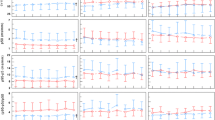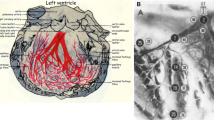Abstract
The right ventricular apex (RVA) is a potential hot spot for development of cardiac rhythm anomalies. Many conditions, including arrhythmogenic right ventricular cardiomyopathy and Brugada’s syndrome affect the RVA, and further, the RVA remains an incompletely characterized pacing region. Whether there are structural reasons underlying these conduction properties remains unsettled. In the current study, we characterize the mechanical strains and structural attributes of the right ventricular wall, and test the hypothesis that the right ventricular apex experiences heterogeneous strain distributions and altered fiber organization, and is thus susceptible to conduction alterations. Electromechanical wave imaging (EWI), or elastography, of hearts was used to quantify mechanical strains occurring through a cardiac cycle. Histological and immunofluorescence imaging techniques were used to examine cardiac wall structure and arrangement of junctional proteins. Right ventricular mechanical strains were elevated and sustained throughout systole, compared to the left ventricle and septum. Heterogeneous strain distributions, myocardial fiber disarray, and altered junctional protein localization occured at the RVA. Disarray and altered strain distributions suggest decreased structural strength at the right ventricular apex in particular and increased mechanical impositions in the right ventricle, respectively. Thus, these data demonstrate why the right ventricular apex may be particularly vulnerable to conduction abnormalities.






Similar content being viewed by others
Abbreviations
- ARVC:
-
Arrhythmogenic Right Ventricular Cardiomyopathy
- RV:
-
Right ventricle
- LV:
-
Left ventricle
- RVA:
-
Right ventricular apex
References
Asimaki, A., H. Tandri, H. D. Huang, et al. A new diagnostic test for arrhythmogenic right ventricular cardiomyopathy. N. Engl. J. Med. 360(11):1075–1084, 2009.
Furman, S., and J. B. Schwedel. An intracardiac pacemaker for Stokes-Adams seizures. N. Engl. J. Med. 261:943–948, 1959.
Grover, M., and S. A. Glantz. Endocardial pacing site affects left ventricular end-diastolic volume and performance in the intact anesthetized dog. Circ. Res. 53(1):72–85, 1983.
Hayashi, M., S. Takatsuki, P. Maison-Blanche, et al. Ventricular repolarization restitution properties in patients exhibiting type 1 Brugada electrocardiogram with and without inducible ventricular fibrillation. J. Am. Coll. Cardiol. 51(12):1162–1168, 2008.
Ho, S. Y., and P. Nihoyannopoulos. Anatomy, echocardiography, and normal right ventricular dimensions. Heart 92:I2–I13, 2006.
Kallel, F., and J. Ophir. A least-squares strain estimator for elastography. Ultrason. Imaging 19(3):195–208, 1997.
Kaplan, S. R., J. J. Gard, N. Protonotarios, et al. Remodeling of myocyte gap junctions in arrhythmogenic right ventricular cardiomyopathy due to a deletion in plakoglobin (Naxos disease). Heart Rhythm. 1(1):3–11, 2004.
Konofagou, E. E., S. Fung-Kee-Fung, J. Luo, and M. Pernot. Imaging the mechanics and electromechanics of the heart. Conf. Proc. IEEE Eng. Med. Biol. Soc. Suppl:6648–6651, 2006.
Kwong, K. F., R. B. Schuessler, K. G. Green, et al. Differential expression of gap junction proteins in the canine sinus node. Circ. Res. 82(5):604–612, 1998.
Leclercq, C., D. Gras, A. Le Helloco, L. Nicol, P. Mabo, and C. Daubert. Hemodynamic importance of preserving the normal sequence of ventricular activation in permanent cardiac pacing. Am. Heart J. 129(6):1133–1141, 1995.
Lee, W. N., J. Provost, K. Fujikura, J. Wang, and E. E. Konofagou. In vivo study of myocardial elastography under graded ischemia conditions. Phys. Med. Biol. 56(4):1155–1172, 2011.
Lobo, F. V., H. A. Heggtveit, J. Butany, M. D. Silver, and J. E. Edwards. Right ventricular dysplasia: morphological findings in 13 cases. Can. J. Cardiol. 8(3):261–268, 1992.
Marcus, F. I., G. H. Fontaine, G. Guiraudon, et al. Right ventricular dysplasia—a report of 24 adult cases. Circulation 65(2):384–398, 1982.
Navarrete, A. Idiopathic ventricular tachycardia arising from the right ventricular apex. Europace 10(11):1343–1345, 2008.
Provost, J., W. N. Lee, K. Fujikura, and E. E. Konofagou. Electromechanical wave imaging of normal and ischemic hearts in vivo. IEEE Trans. Med. Imaging 29(3):625–635, 2010.
Sen-Chowdhry, S., M. D. Lowe, S. C. Sporton, and W. J. McKenna. Arrhythmogenic right ventricular cardiomyopathy: clinical presentation, diagnosis, and management. Am. J. Med. 117(9):685–695, 2004.
Sheehan, F., and A. Redington. The right ventricle: anatomy, physiology and clinical imaging. Heart 94(11):1510–1515, 2008.
Takayama, Y., K. D. Costa, and J. W. Covell. Contribution of laminar myofiber architecture to load-dependent changes in mechanics of LV myocardium. Am. J. Physiol. Heart C. 282(4):H1510–H1520, 2002.
Thiene, G., A. Nava, D. Corrado, L. Rossi, and N. Pennelli. Right ventricular cardiomyopathy and sudden death in young people. N. Engl. J. Med. 318(3):129–133, 1988.
Usyk, T. P., R. Mazhari, and A. D. McCulloch. Effect of laminar orthotropic myofiber architecture on regional stress and strain in the canine left ventricle. J. Elasticity 61(1–3):143–164, 2000.
Wang, S. G., W. N. Lee, J. Provost, J. W. Luo, and E. E. Konofagou. A composite high-frame-rate system for clinical cardiovascular imaging. IEEE Trans. Ultrason. Ferroelectr. Freq. Control. 55(10):2221–2233, 2008.
Acknowledgments
We thank Mahyar Zoghi for his assistance. This work was supported in part by NIH HL102361, and the National Science Foundation Graduate Research Fellowship.
Conflict of interest
None
Author information
Authors and Affiliations
Corresponding author
Additional information
Associate Editor Jay Humphrey oversaw the review of this article.
Rights and permissions
About this article
Cite this article
Hariharan, V., Provost, J., Shah, S. et al. Elevated Strain and Structural Disarray Occur at the Right Ventricular Apex. Cardiovasc Eng Tech 3, 52–61 (2012). https://doi.org/10.1007/s13239-011-0081-3
Received:
Accepted:
Published:
Issue Date:
DOI: https://doi.org/10.1007/s13239-011-0081-3




